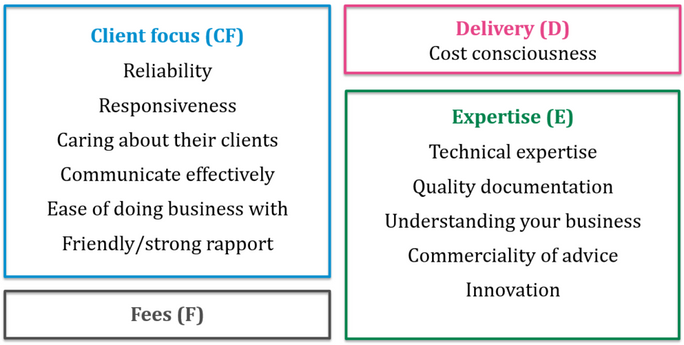beaton has conducted a rigorous factor analysis of the attributes used in the beatonbenchmarks reports. This analysis uses contemporary data to group the attributes measured in our reports, making them easier to interpret and act on.
Leaders should use this information in conjunction with beaton‘s attribute definitions to inform the targeting of their efforts in implementing change.
By targeting improvement in critical attributes, leaders can also achieve improvement in correlated attributes. This lifts clients’ overall experience and perception of a firm. For example, focusing efforts upon improving a firm’s Reliability will also improve that firm’s score in Ease of doing business. Attributes with the biggest impact upon winning and retaining work should be targeted, as evidenced by your beatonbenchmarks reports.
Explanation of factor analysis
Factor analysis is a statistical method used to describe the variability among observed and correlated variables in terms of a lower number of unobserved variables called ‘factors’.
Our research reveals four distinct factors in the beatonbenchmarks, which have been assigned the following names based on their constituent attributes:
- Client focus (CF)
- Expertise (E)
- Delivery (D)
- Fees (F)
Attributes within each factor correlate more closely with each other than with those in other factors. This is detailed in the schematic below. Note that ‘Expertise in your area of need’ was not included in the statistical analysis, but can be reasonably asserted to fall within the Expertise factor.



Overall factor analysis nuances
The factors in the schematic are based on data from all professional services. While there are differences associated with each profession captured in the data, these inter-professional factors represent well how the attributes are generally grouped.
‘Loading’ refers to material correlations between individual attributes and factors of which they are not a part. For instance, ‘Quality documentation’, ‘Understanding your business’ and ‘Commerciality of advice’ are all part of the E factor, but they also load onto the CF factor to a lesser extent. ‘Innovation’ loads onto the D factor.
It should be noted that F is its own factor, with ‘Perception of fees’ being the sole constituent attribute.
D has only one attribute in our overall analysis, namely ‘Cost consciousness’. But in Law and Built and natural environment consulting D is made up of two attributes.
Profession-specific nuances
There some differences in the make-up and loading of factors amongst the professions. As well as demonstrating the inherent relationships between attributes at an overall level, there are subtle distinctions which reflect intuitive nuances within the professions, as follows:
- Accounting: ‘Understanding your business’ is a part of CF , but it also loads onto E. ‘Technical expertise’, ‘Quality documentation’ and ‘Commerciality of advice’ load onto CF. ‘Innovation’ loads onto D.
- Built and natural environment consulting: ‘Commerciality of Advice’ is a part of D, but it also loads onto E. ‘Understanding your business’ also loads onto CF. ‘Innovation’ loads onto D.
- Legal: ‘Innovation’ is a part of D, but it also loads onto E. ‘Communicate effectively’ and ‘Reliability’ also load onto E. ‘Understanding your business’ and ‘Commerciality of advice’ load onto CF.
Attributes within each factor correlate more closely with each other than with those in other factors.
The corresponding post type is disabled. Please make sure to 1) install The7 Elements plugin under The7 > Plugins and 2) enable desired post types under The7 > My The7, in the Settings section.




